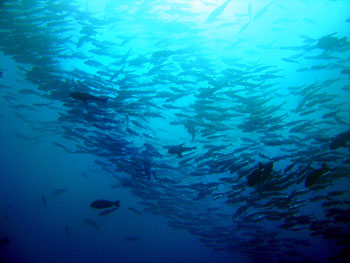Introduction
 A balanced food web is essential to any marine or fresh water system, and can be an indicator of habitat quality. Planktonic algae are the foundation of aquatic food webs. The size and diversity of the planktonic algae community determines the diversity of the zooplankton community that can be supported as well as the small fish community. Algal abundance is determined by water nutrient concentrations, with higher levels of phosphorus and nitrogen resulting in increased algal abundance. This module introduces the concept and important features of an aquatic food web.
A balanced food web is essential to any marine or fresh water system, and can be an indicator of habitat quality. Planktonic algae are the foundation of aquatic food webs. The size and diversity of the planktonic algae community determines the diversity of the zooplankton community that can be supported as well as the small fish community. Algal abundance is determined by water nutrient concentrations, with higher levels of phosphorus and nitrogen resulting in increased algal abundance. This module introduces the concept and important features of an aquatic food web.
The following web pages are the work of a COSEE Coastal Trends Scientist-Educator Team that conducted research on aquatic food webs at Horn Point Laboratory in Cambridge, MD during the summer of 2011. Scroll through the menu on the left margin to discover more about aquatic food webs in the "Learn" and "Explore" pages. To access engaging classroom activities visit, the "Teach" page. Here you'll find lesson plans on predation and prey size, real-time data from Chesapeake Bay buoys, and relationships within a planktonic food web using a computer model.
Credits: Dr. James Pierson, Dr. Neil Banas, Dr. David Elliott, Diane Lee, Daniel Yeager, and the COSEE Coastal Trends staff.



